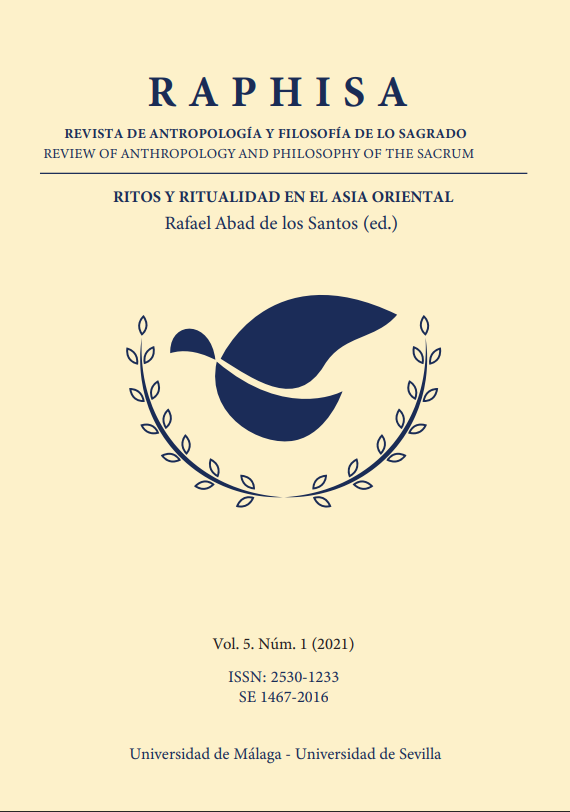Lo sagrado en lo cotidiano: la ceremonia del té en Japón
DOI:
https://doi.org/10.24310/Raphisa.2021.v5i1.12260Keywords:
ceremonia del té, ritual, Japón, cotidianidad, budismo zenAbstract
Current global circumstances have led us to appreciate more our everyday life dimension; at the same time, we can perceive how rituals are disappearing and so, we often feel disoriented and restless while dealing with our everyday routines. This essay aims at showing through approaching Japanese tea ceremony how it is possible to make sacred, through ritualization, an ordinary experience as basic as the one of sharing a tea in good company. To this end, a detailed historical cum philosophical approach is held, distinguishing two big types of ceremony that were held in Medieval Japan (15th-16th centuries). After this historical overview three main features, inspired in Zen Buddhism, will be praised as main values and benefits of this kind of shared everyday ritual: the dimensions of service, a sense of belonging and the feeling of being alive.
Downloads
Metrics
References
BARY, DE, Th., KEENE, D., Tanabe, G. y VARLEY, P. (comps.), Sources of Japanese Tradition. From Earliest Times to 1600, New York: Columbia University Press, 2004.
BLOFELD, John, The Chinese and the Art of Tea, Boston: Shambala, 1985.
CH?MEI, Kamo no, H?j?ki. Un relato desde mi choza. [trad. J. C. Álvarez Crespo]. Madrid: Hiperión, 1998.
HAN, Byung-Chul, La desaparición de los rituales. Una topología del presente, Barcelona: Herder, 2020.
HEISIG, J. et al. (eds.), La filosofía japonesa en sus textos, [Edición española a cargo de Raquel Bouso] Barcelona: Herder, 2016
HUME, N. (ed.). Japanese Aesthetics and Culture. A Reader. New York: SUNY Press, 1995
KEENE, D. Los placeres de la literatura japonesa. Madrid: Siruela, 2018
KENKO, Y., Tsurezuregusa. Ocurrencias de un ocioso [trad., presentación y notas de Justino Rodríguez], Madrid: Hiperión, 2009
KIRBY, John B., From Castle to Teahouse: Japanese Architecture of the Momoyama Period. Tokyo: Tuttle, 1963.
IZUTSU, T. y T. The Theory of Beauty in the Classical Aesthetics of Japan. The Hague and Boston: Martinus Nijhoff, 1981
LANZACO, F. Los valores estéticos en la cultura clásica japonesa. Madrid: Verbum, 2003.
LAO ZI, El libro del Tao, [trad. Iñaki Preciado] Madrid: Alfaguara, 1996.
OKAKURA, K. El libro del té. Madrid: Miraguano, 2004
TATARKIEWICZ, W., Historia de la estética, (vol. I), Madrid: Akal,
TAIZÉ, Brother Anthony of, y Hong Kyeong-Hee, The Korean Way of Tea. An Introductory Guide, Seoul: Seoul Selection, 2007.
TESHIGAHARA, H.(dir.), Riky?, película de 1989.
SAITO, Y. Everyday Aesthetics. Oxford: Oxford University Press, 2006.
SAITO, Y. , «The Japanese Aesthetics of Imperfection and Insufficiency», en Journal of Aesthetics and Art Criticism, vol. 55, nº 4, 1997.
SUZUKI, D.T., El zen en la cultura japonesa, Barcelona: Paidós,1996.
TORNIAINEN, M., From Austere “wabi” to Golden “wabi”: Philosophical and Aesthetic Aspects of “wabi” in the Way of Tea. Helsinki: Finnish Oriental Society, 2000.
VARLEY, Paul, Japanese Culture, Honolulu: University of Hawai’i Press, 2000.
Downloads
Published
How to Cite
Issue
Section
License
License permitted by the journal: Public Domain. Authors retain the copyright and full publishing rights without restrictions.






